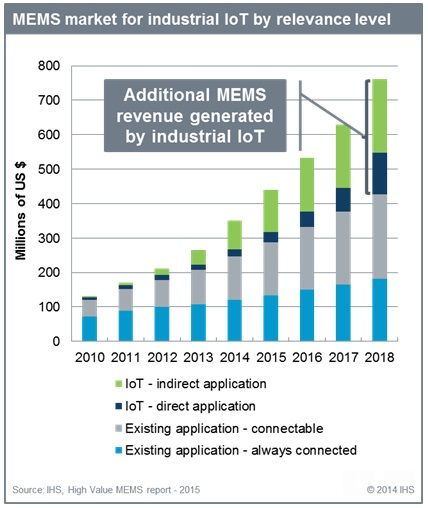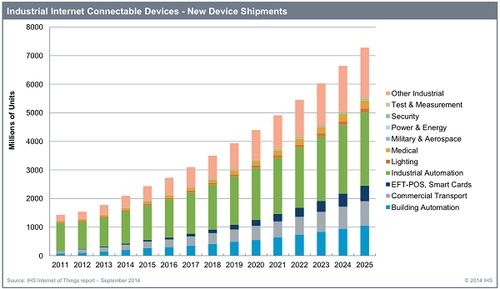Microelectromechanical systems (MEMS) consumer applications have become the focus of attention, but industrial applications are also rapidly evolving. Nowadays, the industry is defining a new type of industrial IoT (IIoT) that utilizes MEMS technology, from asset tracking systems, smart grids to smart building automation, which will have a huge impact on the market.
"I believe that in the next decade, shipments and revenues of MEMS consumer applications will continue to significantly exceed the industrial IoT MEMS market," said Jeremie Bouchaud, senior director of IHS director and MEMS sensors, "IHS is expected in 2018. At the time, global MEMS consumption and mobile applications will reach $5.7 billion, which is much higher than the $334 million generated by the Industrial IoT MEMS market."
However, all of the MEMS industry giants – STMicroelectronics (ST), Bosch, Knowles and InvenSense – are targeting the growth of industrial IoT applications. Traditional industrial IoT applications include navigation, seismic exploration, medical, military, aerospace, and process control. In addition, a range of new industrial applications are growing faster, from smart meters to smart homes to smart cities.

It is expected that by 2018, the industrial Internet of Things-driven MEMS industrial application will bring a market size of $334 million.
(Source: IHS, 2014/12)
IHS predicts that the global MEMS industry IoT market will have approximately 1.8 billion in 2013 and is expected to increase to 7.3 billion in 2015, including stand-alone nodes, controllers and a wide range of infrastructure applications, from smart cards. From commercial transportation to industrial automation to lighting and healthcare.

Hardware device shipments for industrial IoT applications
(Source: IHS, 2014/12)
Bouchaud said that there are more and more MEMS industries used in agriculture and data centers.
For example, farming is becoming more sophisticated and complex. American company ADI has shipped hundreds of thousands of accelerometers for telemetry monitoring systems. The black box of the car and the tracking performance of the item have also become more favorable for predictive estimation than before. These devices are equipped with about ten sensors, and at least in this type of application, accelerometers are a basic requirement. Many companies in the industry sell inertial sensors, including ADI, Freescale (F), and Murata, all benefiting from the remarkable growth momentum of this type of application.
MEMS is also growing rapidly in data centers, where optical MEMS have recovered from previous failures in optical cross-connect (OXC) applications. Bouchaud said: "The library rack is combined into a cluster (server forwarding domain or rack top switch [TOR]), connected to the data center's aggregation server or directly connected to the host network. Because of the data and client Characteristics, the way in which the database and data center TOR are applied, and the flow of data on it are also different. The data center server layer (aggregation layer) is connected to each other's cluster or TOR. This is the first layer of OXC for Assist in managing a large number of optical interconnects."
Wavelength-selective switch reconfigurable optical plug/access multiplexers (WSS-ROADM) are also rapidly gaining popularity, while MEMS sequential components provide a smaller and more accurate clock for synchronous data transfer conversion devices.
IHS predicts that building automation will be the main source of revenue for these industrial applications, followed by asset tracking, smart grids (including smart meters), smart cities, smart factories, seismic monitoring, drones, and robotics. . The data center handles a large amount of information from IoT devices, which will also drive demand for fiber MEMS, from OXC to WSS to MEMS wafer probes.
Compile: Susan Hong
This 10 -port USB 3.0 hub design uses 10 USB 3.0 port to extend to your computer, laptop, reader, network camera, moving HDD, Oculus, Oculus, printers and more USB devices.
This USB 3.0 fast data transmission driver The USB 3.0 center synchronization data transmission speed is as high as 5Gbps. Compatible with Windows XP / Vista / Win 7 / Win 8 / Win 10, Mac OS 10, Linux and above, compatible with USB 2.0 Connections.
10 Port Type-C HUB 3.0, USB HUB 3.0 10 Port, 10-Port USB Hub 3.0
shenzhen ns-idae technology co.,ltd , https://www.best-charger.com